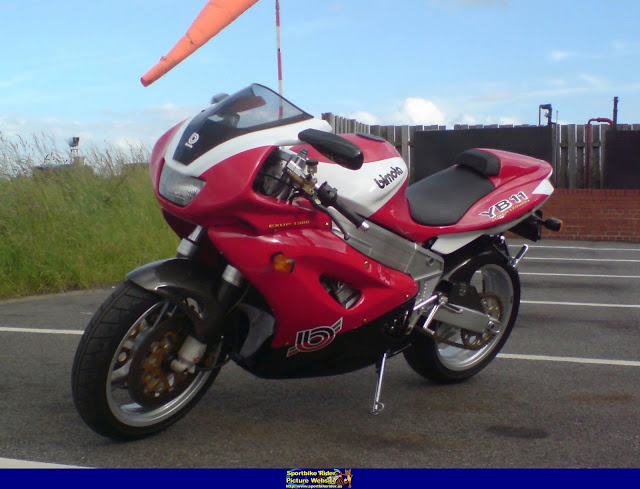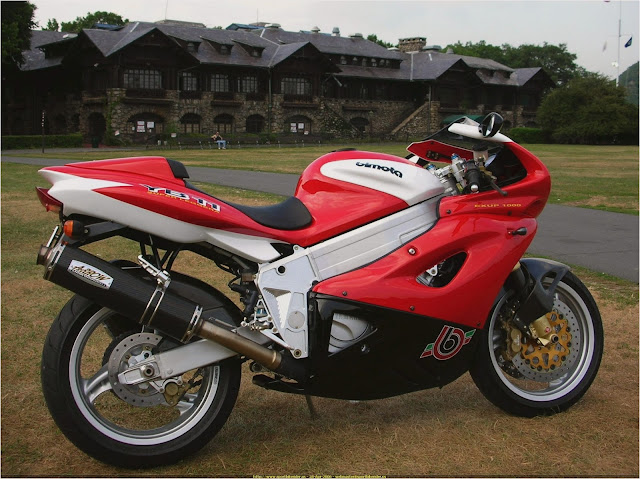Bimota YB11
that many were difficult to equal, let alone better. But Bimota continued to produce super-sports machines offering outstanding performance, notably the YB11 Superleggera of 1996.
Ironically, the YB11 ’s twin-spar aluminium frame, far from being futuristic in Bimota tradition, was closely based on that of the YB6 of several years earlier. But that took nothing away from the YB 11, which was beautifully styled, fitted with top quality cycle parts, and had an uncompromisingly aggressive personality.
The YB11 justified its Superleggera, or ‘superlight’, name by scaling just 4031b (183kg), a substantial 331b (13kg) lighter than the Yamaha YZF1000R Thunderace that supplied its 1002cc four-cylinder engine. Although the frame’s main beams were unchanged from the YB6, the top cross-member was located nearer the steering head, adding rigidity. A sophisticated Paioli rear shock operated a new aluminium swingarm; Paioli also supplied the large-diameter front forks.
Bimota made no internal changes to the 20- valve, liquid-cooled Thunderace motor, which in standard form produced 145bhp. But the Rimini firm fitted a larger airbox, fed via ducts in the fairing nose. According to Bimota. this added a few horsepower in conjunction with a new four-into- one pipe and reworked carburettors.
Although the YBl I shared its engine and chassis type with the YZF1000R, the two bikes felt distinctly different. The Bimota was more racy, w ith firmer suspension, thinner seat and stretched- out riding position. The Italian bike's reduced weight gave a slight edge to straight-line performance, as the Superleggera had a power-to-weight ratio that no mass-produced rival could match.
A crack of the throttle sent the Bimota hurtling forward towards a top speed of 17()mph (274km/h). Peak power was produced at lO.OOOrpm. and the acceleration at high revs was vicious. But its Yamaha engine's greatest strength was mid-range response, and that remained true of the YB 11. It pulled with stunning urgency when the throttle was wound open even from below 4000rpm in top gear.
Like most Bimotas, this was not a practical motorbike. Its suspension was too firm to work properly at low speed on bumpy roads, but on smooth surfaces the bike handled superbly. Its Brembo brakes were wrist-punishingly powerful, and its levels of steering agility, roadholding and ground clearance immense.
Inevitably the YB 11 could not match the performance advantage that some of its predecessors had enjoyed over their mass-produced contemporaries. Equally inevitably, the hand-built Italian bike was hugely expensive as well as impractical. But it was beautiful and rare as well as seriously fast, and enough people were prepared to pay the premium to make the Superleggera a success.
Bimota claimed the YBII produced slightly more power than the standard Yamaha Thunderace whose engine it used. Combined with the Italian bike’s light weight, this resulted in devastating straight-line performance.
Although the YB11 held its 20-valve Yamaha engine in a chassis whose layout was very similar to that of the standard ) ZR1000 Thunderace, the i'alian bike had a distinctly '' tier personality. Its slim ’i?. firm suspension, seat and racy • tr\ gave a typically Bimota feel.
Tesi: the Forkless Failure
Bimota's Tesi, with its futuristic hub-centre front suspension system in place of telescopic forks, was intended to lead the motorcycle world into a new era of advanced chassis design. Chief engineer Pierluigi Marconi's creation, begun when he was a student (Tesi means 'thesis' in Italian), featured a twin-sided swingarm supporting the front wheel, which steered by pivoting on a bearing inside its hub. A series of rods linked handlebars to front wheel.
Powered by the liquid-cooled, eight-valve V-twin engine from Ducati's 851, the Tesi 1D was fast and glamorous when it appeared in 1991. But although its unique chassis gave an advantage when braking into a turn, the Tesi's handling was inconsistent, partly due to the complex steering system being prone to wear. These problems combined with the bike's high price to make the Tesi a failure that Bimota's reputation and finances could ill afford.
Lean styling, broad frame spars and four-into- one silencer gave the Bimota a racy appearance.
The YBIl's frame was a development of the twin-spar aluminium structure introduced on the YB4ie racebike in 1987.
Specification Bimota YB11 (1996)
- Engine Liquid-cooled dohc 20-valve four (Yamaha Thunderace)
- capacity 1002cc (75.5 x 56mm)
- Maximum power 148bhp @ 10,000rpm
- Transmission Five-speed, chain final drive
- Frame Aluminium twin beam
- Suspension Telescopic front; monoshock rear
- Brakes Twin discs front; disc rear
- Weight 403lb (183kg)
- Top speed 170mph (274km/h)
























0 comments: